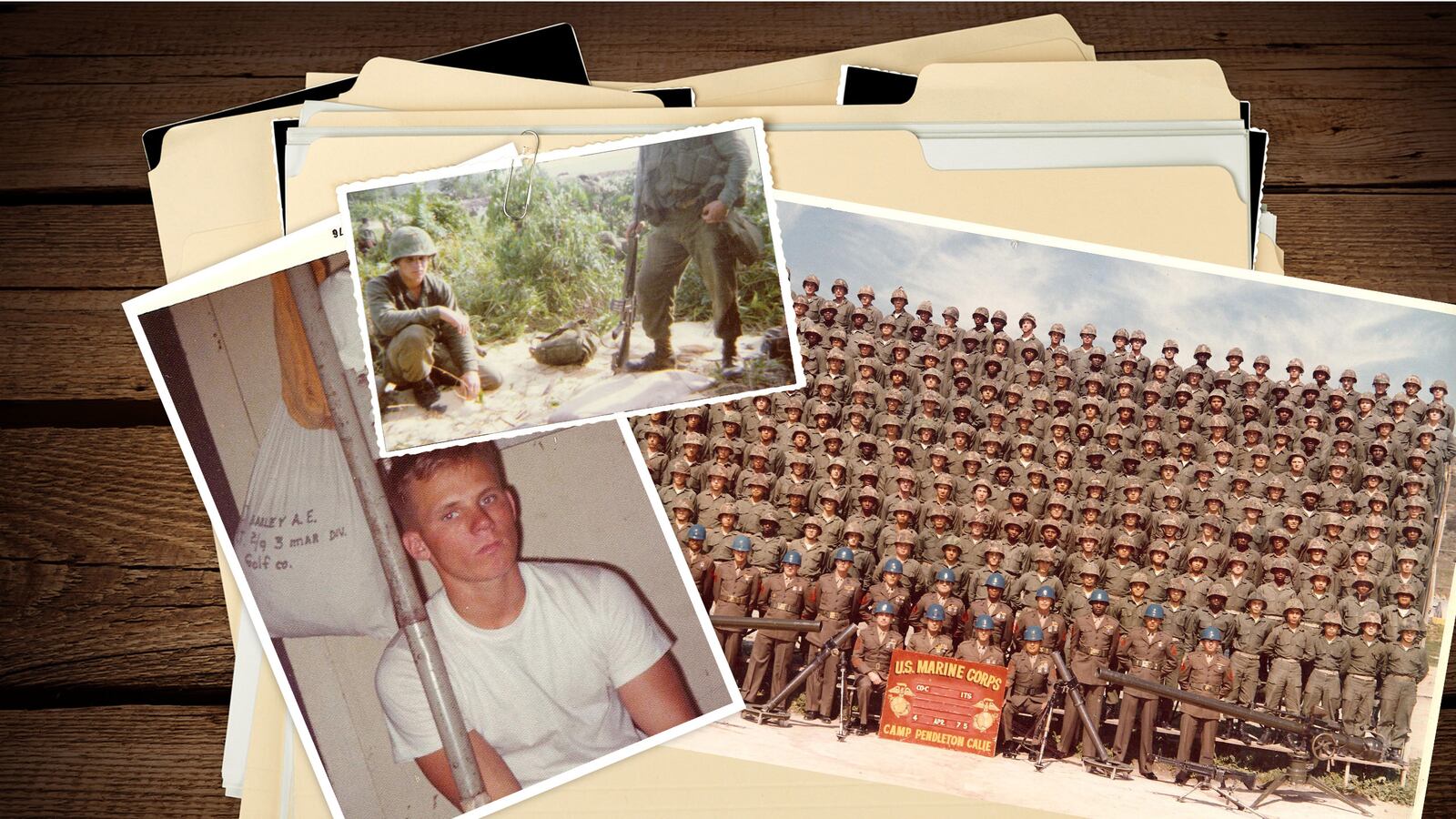Welcome to the second installment of “How the Marines Pulled Off an Impossible Rescue Mission in Cambodia,” a Beast Files series for Beast Inside members only.

The rounds tore into the helicopter like a pitchfork stabbing through metal.
That is how Al Bailey, a 19-year-old Marine Corps private from Maryland, remembers the sounds of the bullets hitting the side of the HH-53 helicopter as it tried to land on the Cambodian island of Koh Tang’s West Beach. His unit of Marines arrived near dawn on May 15, 1975 to rescue 39 merchant sailors being held by the Khmer Rouge.
Light was pouring into the dark cargo area of the helicopter from all the bullet holes. Then the ramp dropped to the beach and Bailey raced into the bright sunlight. He hit the sand and scrambled toward the jungle line. The second he stepped onto the beach, black-clad Khmer Rouge soldiers were shooting at him from less than 175 feet away.
This was Bailey’s first time in combat and things were moving too fast to comprehend. His training and survival instincts kicked in and he started forward until machine-gun fire immediately pinned Bailey and his unit mates on the beach. Huddled near a small wooden hut, Bailey kept his head down.

Al Bailey in Marine dress.
Courtesy Allen Bailey“We were fighting face to face,” a Khmer Rouge soldier told Peter Maguire, a war crimes researcher who interviewed Marines and Cambodian soldiers who fought on Koh Tang. “The American soldiers got out, spread out and opened fire at us. But we counterattacked and they were all dispersed. I can say that they were brave. They were not afraid of being killed.”
Bailey’s platoon was the first one to land on the island, located in the Gulf of Thailand. The American civilians—sailors from the merchant ship the SS Mayaguez—were being held on the island’s East Beach. Intelligence reports placed Khmer Rouge resistance at a minimum—50 soldiers and their families, nothing that the Marines couldn’t handle.
It was 1975 and the U.S. was in the midst of its hangover after losing the Vietnam War. When the sailors were taken, President Gerald Ford decided to show the world America’s might in the form of 600 Marines, but the enemy always gets a vote. The intelligence reports were wrong—as Bailey and his fellow Marines soon discovered. The island was swarming with experienced Khmer Rouge soldiers and their heavy artillery.
The Khmer Rouge held their fire until the helicopter, Knife 21, was less than 100 feet off the ground. Then, suddenly, the jungle was lit up by tracers and gunfire. With the Marines clear, Knife 21 took off, but the helicopter’s engine was damaged. The pilots tried to nurse the helicopter back to Thailand, but it was too late. They ditched offshore. Some of the crew survived, either scrambling up the beach or swimming to a small boat sent from a nearby destroyer hours later.
Bailey was the first off the helicopter. To his left, Knife 22 was coming in for a landing. Machine gun fire forced the pilots to abandon their mission. The helicopter didn’t even touch down on Koh Tang. Instead, it climbed into the air and limped back to Thailand. Once it reached the Thai coastline, it crash-landed with its full contingent of Marines, including the company’s commanding officer. No one was killed.
With the machine guns focused on the helicopters, Bailey and the other Marines rushed up the sand toward the jungle line. Two Khmer Rouge soldiers were directly in front of Bailey. Bailey leveled his M16 and opened fire, walking the rounds toward them. One soldier took a round in the chest and collapsed. The other was winged in the shoulder. He grabbed his fallen comrade and scrambled into the jungle.
They were Bailey’s first shots in anger. Born in College Park, Maryland, he was one of five children. He grew up on a farm dreaming about baseball and war. He learned from a young age that Baileys serve their country. His grandfather fought in the Spanish American War, a cousin was with Admiral Halsey during World War II and his father was a Marine who fought at Guadalcanal and Okinawa.
“I wanted to be a badass,” Bailey said.
Bailey enlisted in the Marines before he finished high school despite a promising baseball and art career. Scouted by the major leagues because of his devastating sinker and a fast ball in the mid-90s, Bailey had a chance to play minor league ball but already signed his enlistment papers. He turned down an art scholarship for the same reason. Shipped to Camp Pendleton for boot camp, he graduated in April 1975, just a month before he found himself under fire on Koh Tang.
Over on the East Beach, close to the action, Knife 31 took a pair of rocket-propelled grenades (RPG’s) in the fuel tank and exploded into a fireball offshore. The pilot, five Marines and two Navy corpsmen died in the crash. The second helicopter, Knife 23, lost its tail when an RPG blew it off. The helicopter crashed on the East beach. Miraculously, all 20 Marines and five crew members survived.
As the sound of the helicopter’s engines faded, the Khmer Rouge machine guns focused on the Marines, now in a half-moon perimeter.
“The gunfire was so intense that hundreds of rounds seemed to be going by my head and body,” Bailey wrote in a narrative about the battle. “Everything moved in slow motion. The battle seemed to last forever, and the heat was intense. The barrage of bullets would move from us to each chopper that tried to insert more troops.”
The rest of the helicopters heading for East Beach diverted to West Beach. In all, 131 American Marines, Navy Corpsman and Air Force crew made it to Koh Tang for the 14-hour battle. But instead of attacking, they were stranded in isolated pockets on the island—and under heavy assault.
Three of the eight helicopters taking part in the rescue operation had crashed or exploded. Four others were so badly damaged they couldn’t continue with the mission. Only three CH-53’s remained to ferry the rest of the Marine force to Koh Tang.
Staff Sgt. Fofomaitulagi Tulifua Tuitele—an imposing American Samoan who had fought in Vietnam—was coming with the second wave. A squad leader with the 2nd Battalion, 9th Marines, he boarded one of the helicopters for West Beach. As they flew in close to shore, he could see smoke from the other downed aircraft. He landed in the middle of a firefight.
His men—including Bailey—were dug into the sand. They were panicked. It felt like Khmer Rouge soldiers were everywhere. All around Bailey, the cacophony of gunfire, some outgoing, most incoming, made it hard to concentrate.
“It doesn’t matter how strong you are,” Bailey said. “It doesn’t matter how smart you are. A bullet ends your life in a matter of seconds. We went in blind against a superior enemy.”
The Marines were spooked, firing at what seemed like shadows. All Bailey could do was press himself into the sand and hope to survive.
Until Tuitele —“Sergeant T” to Bailey and the other men—showed up to take control.
“To him, this was a walk in the park, he was ready to conduct some business,” Bailey told Maguire, the war crimes investigator. “He was like a pissed-off parent who had just found out someone had abused his kids.”

Marines on Koh Tang, 1975.
Courtesy Allen BaileyThere is a big difference between being trained to fight and fighting. But this wasn’t the first time Tuitele had shots fired straight at him. In August 1968, during his second tour of Vietnam, his squad had run up against a company of North Vietnamese soldiers on some nameless hill. The Marines called in air support and watched as jets bombed and napalmed the top of the hill.
Confident the North Vietnamese soldiers were decimated, Tuitele’s squad worked their way up the incline. They didn’t expect any resistance. But as the Marines reached the top of the hill, the North Vietnamese soldiers were entrenched and waiting.
Their gunfire drove the Marines from the hill. One of Tuitele’s friends caught a round in the leg and went down. Tuitele was at the bottom of the hill when he heard his friend calling out for help. Tuitele and his squad mates were out of the kill zone, but he raced back up the hill, ignoring the machine-gun fire from the North Vietnamese soldiers. When he got to his friend, the man’s foot was nearly severed. It was hanging by some tissue.
“I pulled it off,” Tuitele said. “Then I hugged him to me and we rolled down the hill.”
His friend survived and Tuitele was awarded a Bronze Star for his actions. Now seven years later, he was in a similar situation—fighting an entrenched enemy with superior firepower.
Tuitele screamed at his men on the beach.
“Calm the hell down and listen,” he said. “Spread out.”
The men slowly worked their way into a firing line. With the Marines spread out, Tuitele worked his way up and down, giving orders.
“Next time a helicopter comes in, just fire out toward the tree line to keep their heads down,” Sergeant T said. “Only fire when the helicopter comes in. Don’t waste the ammo.”
Two footpaths snaked out of the jungle line. Tuitele squatted near Bailey’s position.

Al Bailey cleaning a rifle, 1975.
Courtesy Allen Bailey“Watch that trail,” Tuitele said to the young Marine private. “Any of those bastards cross the trail, blow their ass away.”
When the next helicopter came in, the jungle erupted with machine-gun fire. The Marines answered it, but it did little to stem the Khmer Rouge attack. If they wanted to survive, they would have to find a way to silence the guns in the jungle.
Tuitele grabbed his M16 and an M79 grenade launcher along with a few grenades. The launcher had a wood stock, which Tuitele figured would make a great club, if it came to that.
“I’m going to take care of this problem,” Tuitele told his men. “No shooting until I get back. And with that, he moved along the line and disappeared into the jungle.
Minutes before the first helicopters landed on Koh Tang to rescue the American hostages—believed to be hidden in bunkers on the island’s East Beach—President Gerald Ford received word that the Cambodians had in fact just released the SS Mayaguez and its crew.
Shortly after 6 a.m., the Khmer Rouge’s information and propaganda minister, Hu Nim, released a statement saying the crew would be freed. The Khmer Rouge had lost two patrol boats to American airstrikes and wanted the Mayaguez’s captain, Charles T. Miller, to call off the bombers. But before Miller could get back to the ship’s radio to contact the American military, the Marines attacked.
Two hours after Nim’s announcement, the crew was placed on a Thai fishing boat and taken on board a nearby American naval vessel.
“We got them all out, thank God,” Ford said when he got the news. “It went perfectly.”
Except for the Marines on Koh Tang. Tuitele and the Marines on both beaches were fighting for their lives with limited ammunition and few experienced leaders. By the time the Ford and his staff puffed celebratory cigars, rejoicing in a mission accomplished, the Marines were just starting one of the longest days of their lives.
Next up ... Sgt. Tuitele goes mano a mano with the enemy while his stranded Marines fight desperately to hold the beach. Keep bingeing this series in our next installment and check out more Beast Files series here.





